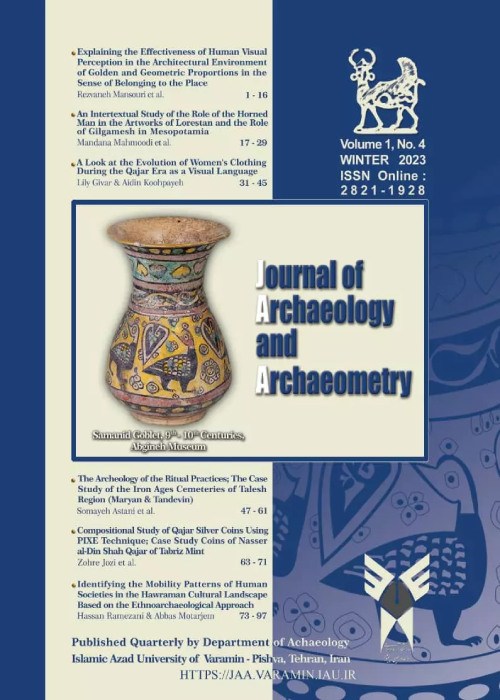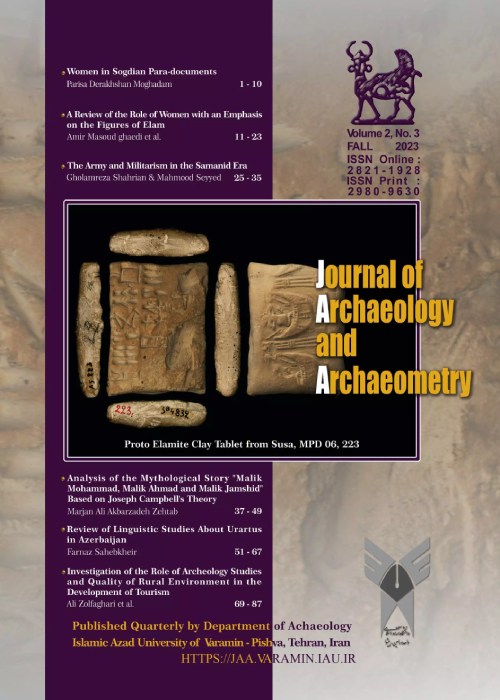فهرست مطالب

Journal of Archeology and Archaeometry
Volume:1 Issue: 4, Mar 2023
- تاریخ انتشار: 1402/02/16
- تعداد عناوین: 6
-
Pages 1-16The ability to recognize and compare shapes and understand the concept of proportions is one of the first human findings from environmental geometric data. And certainly the formation of geometry as a science of recognizing the arrangement of lines, shapes and levels and proportions leads to the definition of golden proportions in the mathematical sciences as a new way of organizing shapes and forms. Golden and geometric proportions are effective as a determining element in the scale of spatial forms, and the formation of spatial forms by not using or misuse of geometric proportions is due to functional and psychological interactions on human perception and cognition. Which causes the construction and formation of scales and proportions of the environment and the emergence of psychological effects due to human activities in the environment. And then the abnormal effects and environmental dysfunction on the saccade system of the human eye and as a result the feeling of fear and lack of belonging to the place interacts. On the other hand, nature as the raw material of creation, and the principle and mother of man, which causes him to model the proportions in nature. Understanding the laws governing the relationships between elements and spatial shapes leads to the formation of geometric and golden proportions in the spending of space. Because knowing the symbol of shapes, proportions and scales in the world of meaning and kingdom is reminiscent of the divine order in all dimensions of the world (even in astronomy). Therefore, evaluating the values of spatial proportions in nature as the bedrock of human life and the pattern of psychological perceptions, leads to the adoption of human activities. Also, the study of human needs on a mental and psychological scale from the perception of the environment causes the recognition of scales and dimensions by human visual senses, which leads to the perception of the correct golden and geometric proportions through Sakadi eye movements and psychophysical sciences. . Certain ratios can also be observed in the creation and design of various shapes in nature. These relations are those geometric relations that have immaterial roots and follow the spiritual and supernatural principles, believing that their subject is sacred, and have a symbolic language and spiritual characteristics. In the traditional world, geometry was inseparable from the other four Pythagorean sciences, namely arithmetic, music, and astronomy. And traditional geometry is also associated with the symbolic composition and shapes of space. To this end, the study of the effect of golden and geometric proportions on human visual perception of the architectural environment based on the sense of belonging to the place, causes visual quality to increase the sensory richness of the place and achieve human values and criteria in the sense of belonging to the place and human needs. To be considered by the architect. In this research, with the perspective of this identity and the interaction of geometric and golden proportions and the sense of belonging to the place, the criteria and indicators of the research have been studied and the results have been presented in the form of tables and diagrams.Keywords: Golden Proportions, Geometric Proportions, visual perception, sense of belonging to place, sense of place
-
Pages 17-29Mythologies are closely related to each other because of the archetypes, and due to time, place, and specific geography, they appear in different forms in different peoples. Gilgamesh is considered the oldest Mesopotamian epic poem whose image can be seen on Lorestan bronzes in the second and first millennium BC in the form of a horned man supporting, killing, or taming animals. Identifying the visual relationship between the role of the horned man in Lorestan bronzes and Gilgamesh in Mesopotamian works in order to discover the common intellectual heritage between these two regions is the main goal of this research. The main question of this research is about what and why are the technical and visual similarities and differences of the paintings, which have dealt with the background of Gilgamesh's role in the Mesopotamian civilization with a descriptive-analytical method, and then, with an analytical method, he analyzed the relationship between the role of the horned man in Lorestan's bronze works and the role of Gilgamesh in Mesopotamian art based on the theory of pre-textuality. The results show that the artist of Lorestan created a work of art under the influence of Mesopotamian mythology and art which are similar in visual and narrative components, but according to the culture and customs of the region, differences can be seen in the performance style and the structure of the topics, which shows that Lorestan artist did not imitate Mesopotamian themes. Rather, it has created a new work of art by creating transformational relationships with changes in the pretext.Keywords: Gilgamesh, Bronzes of Lorestan, Horned Man, Pretext
-
Pages 31-45
The final goal of this research is to investigate the design of Qajar women's clothing in different periods. In the first step, the question arises whether the cover can be a language. Then this research seeks an answer to the question of what messages in the form of language mean. Therefore, in the current research, the above issue has been analyzed by a case study of Qajar women's clothing and using a descriptive-analytical qualitative research method. Findings This study shows that the clothing of Qajar women can be considered a single language of signs. In deciphering this language, concepts such as women's attention to religious foundations, gender inequality, and patriarchal view in society, the value of wearing Iran's old traditions, as well as the desire to move towards westernization and fashionism of Europeans can be inferred. The results of this research show the importance of the role, color, code, sign, symbol, and finally language in the field of women's clothing in the Qajar period.
Keywords: Clothing, Women, Qajar period, language, signs, Linguistics, Semiotics -
Pages 47-61During the life of humans on earth, there has been no subject more interesting and complicated than death. The knowledge and understanding of what will happen to a person after death form the basis of most religions in the world, which have since been referred to as religious matters or religious experiences. The issue of death is so important in many societies that it has caused the birth of schools of thought and, as a result, the growth of various religions and cults. Burial customs include the structure of the graves, the direction, and condition of human or animal skeletons, and the placement of objects in the graves. The Iron Age in Iran and Guilan is divided into three sections: Iron Age I, II, and III. This Period includes from 1500 B.C. to 550 B.C., of course, some archaeologists believe the existence of Iron Age IV, which continues until the middle of the Parthian period (the End of 1st Millennium B.C.). All major discoveries from selected Iron Age sites in the area of Guilan have been explained and classified. In this research, a new attempt has been made to review the religious experience and ritual practices regarding the repeatability of ancient cemeteries of Talesh during the Iron Ages. The main aim of this article is to identify the Iron Age Burial culture in Guilan. This investigation shows that the society’s People of Iron age in the area of Talesh have social Rank and Status but the factor of Gender is not important in classifying their classes.Keywords: Ritual Practice, cemetery, Guilan, Iron age, Burial Customs
-
Pages 63-71
The study of the elemental composition of silver coins minted in the Tabriz during the Qajar period can help to investigate the socio-economic situation of that period. In this case study, Proton- Induced X-ray Emission (PIXE) analytical technique has been applied to twenty-eight Qajar silver coins selected from a private collection. the purpose was to study and investigate the changes in silver elements in Qirans of Nasser al-Din Shah Qajar in Tabriz mint. The metallic elements Ag, Cu, Fe, Pb, and Au were observed. The results show that the content of Ag the main constituent of the coins varies from 90.07 to 82.88%. this significant variation in the content of the major constituent reveals the economic difficulties encountered by the dynasty. The results, which are shown by using the PIXE technique, brought to light valuable information about the economy of the period under study.
Keywords: Silver Coin, Qajar, Naser al-Din Shah, PIXE Analysis -
Pages 73-103The lifeways of mobile human societies are a field investigated by anthropologists and archaeologists. Mobility is considered an effective way of foraging and resource production among human societies (for hunter-gatherers, pastoralists, and farmers, respectively). Various classifications regarding the mobility patterns of human societies have been proposed so far. As of today, the majority of archaeologists use Murdock’s multi-purpose classification which divided mobile human societies into four groups: (1) Nomadic societies, (2) semi-nomadic societies, (3) semi-sedentary societies, and (4) sedentary societies. But some societies have characteristics that do not allow them to be placed in one of these groups. For identification of these unclearly defined societies, the authors will refer to 5 criteria of demographic dimensions: Mobility, number of movements, movement distance, residential criteria, and lifeway. For instance, it was not until 2003 that archaeologists began to recognize the intermediate trajectory of nomadic pastoralism from early village-based herding to the formation of full-fledged pastoralism in the western part of Central Zagros. Extensive study of pastoralist communities, however, can be used for the identification of several intermediate stages of the 5 criteria. Current archaeological evidence in most of the early Neolithic sites in Central Zagros such as Qazanchi, Sheikhi Abad, Sarab, Asiab, and Guran, unlike the Levant region which was settled in the Epipaleolithic (Natufian) period, indicates that these sites are seasonal. So how can we explain the mobility of human societies in the proto-Neolithic period of Zagros? As a result, the authors try to use these criteria to identify the intermediate stages of sedentarism in Zagros, from mobile societies in the Epipaleolithic period to sedentary societies in the late Neolithic period. For this purpose, the authors have studied the mobility patterns and residential criteria of human societies in the cultural landscape of Hawraman. The research was conducted in two seasons, in the summer of 2016 and the summer of 2018, respectively. At first glance, the patterns of mobility and lifeways of human societies seemed homogeneous and identical in the cultural landscape of Hawraman. But with a deeper analysis, Four main mobility patterns were identified. The patterns include (1) single-stage agriculturalist residential mobility in Koh-e-Takht, (2) multistage pastoralist residential mobility in Kosalan and Shahu Mountain, (3) logistical mobility (transhumance) in Javeh River, and (4) logistical mobility (based on cultural exchanges) all over the Hawraman. The patterns show that the Zagros societies did not become sedentary in a single stage. Therefore, semi-sedentary societies with residential mobility and semi-sedentary societies with logistical mobility can be placed in the intermediate stages.Keywords: Ethno-archaeology, Neolithic, Semi-Sedentary, Hawraman


